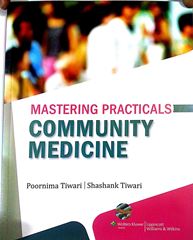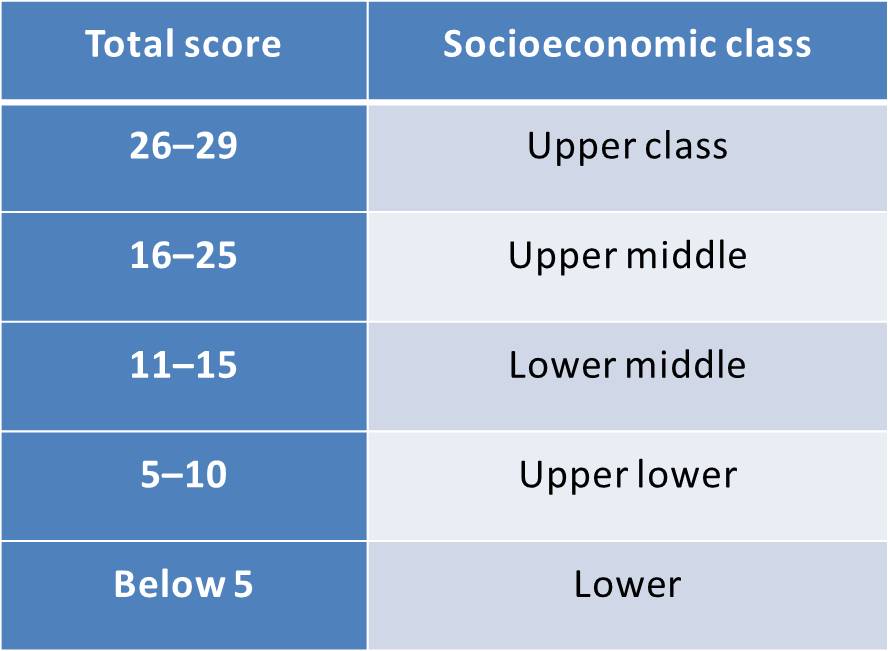
This is the most commonly used scale for determining the SES of an urban family. Kuppus- wamy scale was developed for assessing the SES of an urban individual. It took three parameters into account, namely, education, occupation, and income of the individual
It was modified to enable SES assessment of a family rather than an individual. The parameters were modified as education and occupation of the HOF and the income of. the whole family, pooled from all the sources . These parameters are defined later in this section.
The total score is calculated by adding up all the three scores, namely, education, occupation, and total family income. According to the total score thus calculated, the family is placed in the appropriate socioeconomic class as explained in the following Table.
Table: 
Income of the whole family:
Since the time Kuppuswamy scale has been modified to determine the SES of the family rather than an individual, confusion has prevailed whether the income categories are meant to represent the total family income or per capita income.
The general consensus is that the original modification might have been for the whole family income, even against the argument that this does not consider the family size and may misclassify large families.
We suggest that the student may calculate the socio economic class of the family by applying both i.e. once by using ‘total family income’ and next by using ‘per capita family income’. The resulting categories can be compared and any difference may be commented upon while presenting the family to the examiner.
Per Capita Family Income
The income from all the sources should be added up. This is divided by the total number of members of the family, regardless of the age of the individual. For example, even a baby born on the same day is to be counted.
The income groups are revised from time to time according to the prevailing All India Consumer Price Index (AICPI). The student should check for the latest cut offs. The last revision before this article has been done using price index of January 2019 (Table below).
A formula has been developed for future regular updating of the income limits, which uses the latest Consumer Price Index for Industrial Workers (CPI-IW). The latest CPI-IW is available on the web page at http://labourbureaunew.gov.in/LBO_indnum.htm.
For facilitating the calculation of cut offs, an online tool is available at: http://scaleupdate.weebly.com/real.html , which calculates the cut offs once the latest CPI – IW is entered.
Deciding the Occupation Category:
The occupational category of “profession” includes persons who are at a high position and are involved in the decision-making process, laying down policies, and executing them. Most of them have received high education but it is not always the case. To this category belong doctors, senior administrative officers, senior lecturers, college principals, advocates, planters owning large estates, expert musicians, newspaper editors, auditors, architects, managing directors of firms, bank managers, etc.
The “semi-professional” group consists of occupations which involve college education. They may also involve lower grade professional training, but the jobs are essentially of a routine nature. Included in this group are mechanical and electrical engineers, high school teachers, lecturers, junior administrators, junior doctors, insurance inspectors, commission agents, musicians, research assistants, etc.
The third category persons need some training in arithmetic and reading and writing. The work here is also essentially of a repetitive nature. Some typical examples are clerk, typist, and accountant. A shopkeeper as well as a farm owner cannot continue unless they know how to keep accounts and look after the routine management. Many railway occupations such as station master and guard fall under this. Others such as news correspondent, salesman, insurance agents will continue in this category as long as they operate at the routine level. If they show greater initiative, they move into higher categories.
To the “semiskilled” group belong all those persons who need some training to do their routine jobs efficiently, e.g., factory or workshop labourer, laboratory or library attendant, and car cleaner. The petty shopkeeper may also be put into this category because he cannot pursue his occupation without some training regarding where to purchase, how to purchase, and how to sell.
“Unskilled worker”: All those who are doing work which involves neither education nor training will come under this category, e.g., watchman, peon, domestic servant, and rickshaw puller.
Unemployed: The lowest category consists of persons who are unemployed irrespective of their general and professional education or training.
References:
• Poornima Tiwari, Shashank Tiwari. Chapter – 13 In: Mastering Practicals in Community Medicine, 2nd ed. Lippincott Williams and Wilkins, New Delhi.
• Aggarwal OP, Bhasin SK, Sharma AK, Chhabra P, Aggarwal K, Rajoura OP. A new instrument (scale) for measuring the socioeconomic status of a family: preliminary study. Indian J Community Med 2005;30(4): 111–4.
• Mishra D, Singh HP. Kuppuswamy’s socioeconomic scale—a revision. Ind J Ped 2003;70: 273–4.
• Kuppuswamy B. Manual of Socioeconomic Status (Urban). Delhi: Manasayan; 1981.
• Sharma R, Saini NK. A modification regarding the Kuppuswamy socioeconomic scale. Chron Young Sci 2014;5:84-5
• Sharma R. Kuppuswamy’s Socioeconomic Status Scale—Revision for 2011 and Formula for RealTime Updating. Ind J Pediatr 2012 [Epub ahead of print].
• Kuppuswamy's SES Scale for 2019, Online Tool: Available at: http://scaleupdate.weebly.com/real.html ; accessed on 27th March 2019
Modified Kuppuswamy Classification of Socio - Economic Class: http://www.ihatepsm.com/blog/modified-kuppuswamy-scale
Prasad's Scale: http://www.ihatepsm.com/blog/prasad%E2%80%99s-scale
Dependency Ratio: http://www.ihatepsm.com/blog/dependency-ratio
Assessment of Overcrowding in a Household: http://www.ihatepsm.com/blog/assessment-overcrowding-household
Checking Adequacy of Lighting in a Room: http://www.ihatepsm.com/blog/checking-adequacy-lighting-room
Assessment of Adequacy of Ventilation: http://www.ihatepsm.com/blog/assessment-adequacy-ventilation
Family and the Types of Family: http://www.ihatepsm.com/blog/family-and-types-family
Checking for Mosquito Breeding Areas in a Household: http://www.ihatepsm.com/blog/checking-mosquito-breeding-areas-household
Life Cycle of Housefly: http://www.ihatepsm.com/blog/life-cycle-housefly
Types of Piped Water supply: http://www.ihatepsm.com/blog/types-piped-water-supply
Reference Indian Adult Man and Woman: http://www.ihatepsm.com/blog/reference-indian-adult-man-and-woman
Concept of the “Consumption Unit”: http://www.ihatepsm.com/blog/concept-%E2%80%9Cconsumption-unit%E2%80%9D
Methods of Dietary Survey: http://www.ihatepsm.com/blog/methods-dietary-survey
24-Hour Recall (Questionnaire) Method: http://www.ihatepsm.com/blog/24-hour-recall-questionnaire-method
Determination of Socio-economic Status of a Family in a Rural Area (the Uday Pareekh Scale): http://www.ihatepsm.com/blog/determination-ses-family-rural-area-uday-pa...
7 Terms used in Maternal and Child Health: Definition and Explanation: http://www.ihatepsm.com/blog/7-terms-used-maternal-and-child-health-defi...
Terms used in Family Health Study: Definitions and Explanations: http://www.ihatepsm.com/blog/terms-used-family-health-study-definitions-...
Lecture on the definitions and explanations of terms used in Family Health Study: http://www.ihatepsm.com/resource/terms-used-family-health-study-definiti...
Hindi lecture on the definitions and explanations of terms used in Family Health Study: http://www.ihatepsm.com/resource/terms-used-family-health-study-definiti...
Hindi lecture on CSC taking: https://www.youtube.com/watch?v=9gvuXrIJ_gY&t=10s
English lecture on CSC taking: https://www.youtube.com/watch?v=rKxXIyJuBz8&t=24s
Format for CSC taking: http://www.ihatepsm.com/blog/format-clinico-social-case-taking-community...
Geriatric CSC taking: http://www.ihatepsm.com/blog/geriatric-clinico-social-case-community-med...
